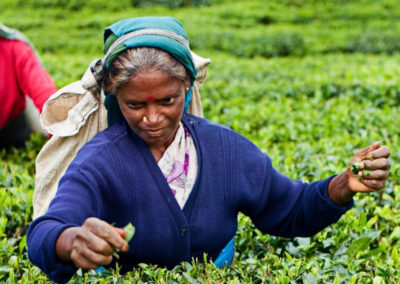Tea was introduced to Sri Lanka by the British and pioneered by James Taylor in 1867. The tea industry flourished, and Ceylon has come to be recognised as the world’s finest tea and has grown to be one of the main agricultural exports of Sri Lanka.
Approximately 4% of the highland and lowland land area is covered in lush green tea plantations, with a total labour engagement of approximately 1 million people.
Tea grown in different geographical areas is classified and graded according to its elevations. Highland grown tea is normally sourced from plantations that are 1200m from the sea level, medium grown teas from elevations around 600- 1200m, and low grown teas are sourced from sea level up to an elevation of 600m.


When you are travelling in areas like Nuwara Eliya, Kandy and the Sabaragamuwa region, and parts of the Southern region, you will witness a sea of lush greenery which are tea plantations that cover vast areas of land. Should you make a stop at one of these plantations you will meet the ever-smiling tea pluckers who trek through the plantations carrying a pole in their hands and a woven basket on their back. Sri Lankan tea is normally hand-picked and the two top leaves and the bud are used. The tea produced in these different areas each carry their own unique flavours due to the elevation, climatic conditions, and the quality of soil.
Sri Lanka is renowned for its black tea, not forgetting the current trend of Ceylon green tea and the ranges of flavoured tea which are exported to almost all tea-drinking countries in the world. Additionally, silver and golden tips with distinctively unique flavours are also being produced and these are considered amongst the most expensive teas in the world.
We highly recommend that you indulge in the unique flavours of Ceylon tea during your visit.








